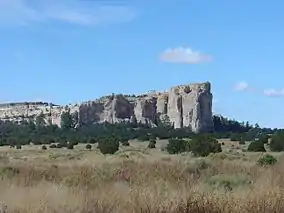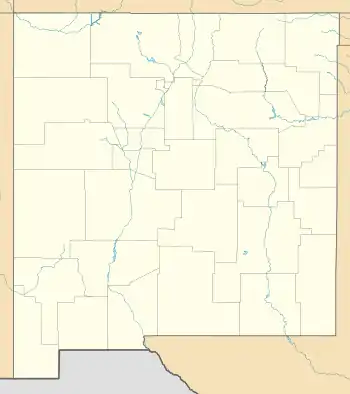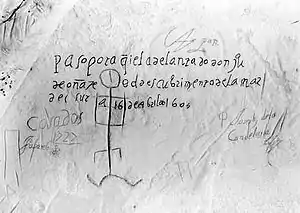El Morro National Monument
El Morro National Monument is a U.S. national monument in Cibola County, New Mexico, United States. Located on an ancient east–west trail in the western part of the state, the monument preserves the remains of a large prehistoric pueblo atop a great sandstone promontory with a pool of water at its base, which subsequently became a landmark where many centuries of explorers and travelers left historic inscriptions that survive today.
| El Morro National Monument | |
|---|---|
IUCN category III (natural monument or feature) | |
 | |
  | |
| Location | Cibola County, New Mexico, USA |
| Nearest city | El Morro, New Mexico |
| Coordinates | 35°2′18″N 108°21′12″W |
| Area | 1,278.72 acres (5.1748 km2) 1,039.92 acres (420.84 ha) federal |
| Created | December 8, 1906 |
| Visitors | 68,867 (in 2019)[1] |
| Governing body | National Park Service |
| Website | El Morro National Monument |
El Morro National Monument | |
| Area | 221 acres (89 ha) |
| NRHP reference No. | 66000043[2] |
| NMSRCP No. | 59 |
| Significant dates | |
| Added to NRHP | October 15, 1966 |
| Designated NMSRCP | May 21, 1971 |
Between about 1275 to 1350 AD, up to 1,500 people of the Ancestral Puebloan culture lived in the 875-room mesa-top pueblo. The village was situated on the old Zuni-Acoma Trail, an important prehistoric trade route. Spanish explorers visiting the area in the 16th century referred to the notable promontory as El Morro ("The Headland"); the local Zuni Indians call it A'ts'ina ("Place of writings on the rock"), and early Anglo-Americans called it Inscription Rock.
With its oasis-like source of water, El Morro served as a stopping place for numerous travelers through the otherwise arid and desolate region, many of whom left signatures, names, dates, and stories of their treks in the walls of the sandstone cliff. While some of the inscriptions are fading, there are still many that can be seen today, with some dating to the 17th century. The oldest historic inscription at El Morro, left by Juan de Oñate, the first Spanish governor of the colony of Santa Fe de Nuevo México, is dated April 16, 1605. Among the Anglo-American emigrants who left their names there in 1858 were several members of the Rose-Baley Party, including Leonard Rose and John Udell.[3] Nearby petroglyphs and carvings made by the Ancestral Puebloans were inscribed centuries before Europeans arrived. In 1906, U.S. federal law prohibited further carving on the cliffs.
El Morro was designated a national monument by President Theodore Roosevelt on December 8, 1906, and was added to the National Register of Historic Places in 1966. Today the site is managed by the National Park Service. The many inscription panels, water pool, pueblo ruins, and the top of the promontory are all accessible via park trails. El Morro is one of many prehistoric sites on the Trails of the Ancients Byway, a designated New Mexico Scenic Byway.[4] The monument was featured in the film Four Faces West (1948), starring Joel McCrea.[5] In December 2019, the International Dark Sky Association certified El Morro as an International Dark Sky Park,[6] recognizing its preservation of not only the historic inscriptions but also its natural night sky.
Gallery
 Inscription by Juan de Oñate in 1605. This is the oldest historical inscription at El Morro.
Inscription by Juan de Oñate in 1605. This is the oldest historical inscription at El Morro. Inscription recording a 1629 expedition by Francisco Manuel de Silva Nieto
Inscription recording a 1629 expedition by Francisco Manuel de Silva Nieto El Morro in 1868, photographed by Alexander Gardner
El Morro in 1868, photographed by Alexander Gardner Native American petroglyph
Native American petroglyph Sandstone bluff at El Morro
Sandstone bluff at El Morro Ponderosa pine along Mesa Top trail loop
Ponderosa pine along Mesa Top trail loop
See also
- National Register of Historic Places listings in Cibola County, New Mexico
- List of National Monuments of the United States
References
- "Annual Visitation Report by Years: 2009 to 2019". nps.gov. National Park Service.
- "National Register Information System". National Register of Historic Places. National Park Service. July 9, 2010.
- Weigle, Marta and White, Peter (2003). The Lore of New Mexico, p. 56. University of New Mexico Press
- Trail of the Ancients. Archived August 21, 2014, at the Wayback Machine New Mexico Tourism Department. Retrieved August 14, 2014.
- Maddrey, Joseph (2016). The Quick, the Dead and the Revived: The Many Lives of the Western Film. McFarland. Page 181. ISBN 9781476625492.
- December 17, on; 2019 (2019-12-17). "El Morro National Monument Certified as an International Dark Sky Park". International Dark-Sky Association. Retrieved 2020-01-04.CS1 maint: numeric names: authors list (link)
- United States Government Printing Office (1995). El Morro National Monument. GPO 387-038/00173
External links
| Wikimedia Commons has media related to El Morro National Monument. |